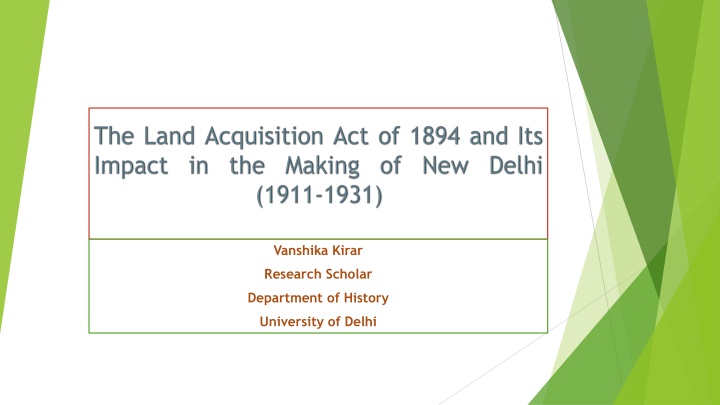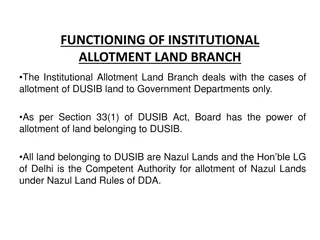The Shifting of India's Capital: The Story of New Delhi
The decision to move the capital of India from Calcutta to Delhi in 1911 led to the creation of Imperial Delhi, now known as New Delhi. This move was a reflection of British colonial rule in India, marked by controversies, cost overruns, and disagreements among architects. The shift was influenced by nationalist sentiments, strategic interests of the British Empire, and the desire to give Bengal equal status. The choice of Delhi as the new capital was also intertwined with its historical and sacred significance.
Download Presentation

Please find below an Image/Link to download the presentation.
The content on the website is provided AS IS for your information and personal use only. It may not be sold, licensed, or shared on other websites without obtaining consent from the author.If you encounter any issues during the download, it is possible that the publisher has removed the file from their server.
You are allowed to download the files provided on this website for personal or commercial use, subject to the condition that they are used lawfully. All files are the property of their respective owners.
The content on the website is provided AS IS for your information and personal use only. It may not be sold, licensed, or shared on other websites without obtaining consent from the author.
E N D
Presentation Transcript
Vanshika Kirar Research Scholar Department of History University of Delhi
The Building of New Delhi At the coronation durbar held in Delhi in December 1911, the new King, Emperor George V, proclaimed the transfer of the capital of India from Calcutta to Delhi. The result , as Robert Grant Irving describes, was the creation of Imperial Delhi (or New Delhi). A deliberate and explicit political act, the city was envisaged as a manifesto of British rule in India. Yet from the very first, Imperial Delhi provoked bitter disputes and controversy. The transfer of the capital itself, the choices of site and style, spiralling costs, and antagonism between Lutyens and Baker, the two main architects... As a result the city was not inaugurated until 1931, amid pageantry widely viewed as a requiem for British authority in India. The whole thing cost the Indian people very dearly; more then Rs.18 crore was spent on this Imperial project.
The decision to make it the new capital was only taken in 1911. The process of setting up the new imperial city was not a simple architectural or urban planning exercise; it emerged out of intense debates relating strategic interests of the British Empire in India. It also involved intense discussions regarding the site of the new capital, choice of architects, style of architecture, acquisition of land and design of individual buildings all of which played an important part in the making of New Delhi. to the changing layout of the city,
The whole process was further complicated by the outbreak of the First World War, time and cost overruns, and differences between the two leading architects, Edwin Lutyens and Herbert Baker. Why was a decision taken to shift the capital from Calcutta to Delhi? Nationalist opposition to colonial rule was building up in Calcutta, which had been the seat of the British administration for around 150 years. Further, Lord Curzon s partition of Bengal the creation of a new province of Eastern Bengal and Assam with the Muslim city Dacca (Dhaka, now capital of Bangladesh) as the capital had caused a huge uproar, leading to a boycott of foreign goods, the development of a movement for swadeshi enterprises and, later, bombings and political assassinations. Calcutta was becoming a less hospitable home for the British.
There were at least two primary ideas at the heart of the discussions surrounding the transfer of the capital. The first was to reunify Bengal and in some way assuage the hurt nationalist sentiments. Connected to this was the second idea of giving Bengal the same status and autonomy as the Madras and Bombay presidencies. It was argued that the Supreme Government should not be associated with any particular Provincial Government and that in the long run the provinces should have a larger measure of self-government.
Why was Delhi chosen? It was an ancient city associated with Hindu mythology and sacred legends. It had a more central location and was closer to the summer capital, Shimla. Some even argued it had a better climate. More importantly, Delhi had been a seat of power under the Delhi Sultanate and the Mughals, and the government wanted to build on this symbolic association too. Further, the 1857 rebellion had shown the symbolic importance of Delhi and the emotional connect people had with it and the Mughal emperor. Interestingly, during the Coronation Durbar, George V and Queen Mary even appeared before the Delhi public from a jharokha (overhanging enclosed balcony) at the Red Fort trying to appropriate an imperial symbolism and a practice only reserved for emperors to reiterate their supremacy over the subcontinent.
Imperial ideology and architecture The Delhi Town Planning committee was formed, and Lutyens (who had designed a garden city and country homes in England) was appointed as the consultant to draw up a master plan. Viceroy Lord Hardinge himself was involved in the planning of the new capital in a major way. The historian Percival Spear says the architectural committee of Lutyens (an architect), John A. Brodie (an engineer) and S.C. Swinton (a municipal issues expert who also had knowledge of Indian architecture) chose a site on Raisina Hill, south of Shahjahanabad, reversing an earlier decision to build the capital on a site north of the Mughal capital. They saw the new site as an Indian Acropolis, with the proposed Viceroy s House (now Rashtrapati Bhavan) as the Parthenon. The architect and heritage expert Lucy Peck says that the Viceroy s insistence that the capital should be completed in four years made Lutyens rope in Baker, a friend and architect who had designed colonial buildings in South Africa. Baker could only join in 1913, by which time most of the decisions had been taken. It was agreed that Lutyens would design the Viceroy s House and the overall layout of the city, whereas Baker would take care of the twin secretariat buildings (now North and South blocks).
Layout The art historian Vidya Dehejia says features such as monumental classicism, vast ceremonial avenues, open spaces, geometrical symmetry and a grand central axis characterised New Delhi s outlay plan. The heart of the new imperial city was the Viceroy s House located on the top of Raisina Hill and flanked by the twin secretariat buildings. The viceregal estate and the crescent (which is an architectural arrangement of buildings along an arc or curved street) behind the Viceroy s House, Willingdon Crescent (now known as Mother Teresa Crescent), contained residential accommodation for important functionaries. The main streets were supposed to have beautiful vistas at their ends. King s Way (now Rajpath, or Avenue of the State ) was the principal imperial axis and was supposed to connect Purana Qila (or Old Fort, associated with the Afghan ruler Sher Shah Suri and the Mughal emperor Humayun) to the Viceroy s House via the war memorial arch (India Gate) and Victory Square (Vijay Chowk). Queen s Way (now Janpath, or Avenue of the People ) crossed the principal axis at right angles, connecting the central commercial hub Connaught Place and a host of important buildings with South End Road (now known as Rajesh Pilot Marg). Further beyond Connaught Place in the north was the Jami Masjid, the grand congregational mosque of the 17th century Mughal capital, Shahjahanabad.
The Land Acquisition Act, 1894 The power of the sovereign to take private property for public use and the consequent rights of the owner to compensation are well-established. A critical examination of the various stages of evolution of this power and its ethical basis will serve no useful purpose as the power has become firmly established in all civilized countries. In England, the source of the power is Parliament. The earliest consolidating enactment was the Land Clauses Consolidation Act, 1845. This has to a large extent been altered by later statutes.
Under the Land Acquisition Act, the Government of India had a variety of ways to compensate dispossessed landowners. It could offer single cash payments or revenue remissions on properties not acquired by the government. The government could also offer lands of equal value in exchange for acquired lands. Government discussions about compensation for lands acquired for New Delhi began as early as December 1912. Hoping to avoid any controversy that might undermine his plans for New Delhi, Hardinge encouraged Geoffrey deMontmorency, the interim president of the Imperial Delhi Committee, to seek the most equitable compensation for dispossessed Delhi landowners. A heated debate began over which form of compensation land, cash, or revenue remission would be most satisfactory for dispossessed Delhi landowners. Yet in many ways, the debate was not about compensating Indians but about the relationship between the rule of law, land, and the free market.
The Government of India authorized the Land Acquisition Office to offer cash awards as full compensation for lands acquired for the building of the new capital. No lands would be given in compensation. Instead, lands would be reserved for purchase in the Karnal, Rohtak, and Lower Bari Doab. The Land Acquisition Office advised dispossessed residents to bank their cash awards and to report on a specified date to the courts of Deputy Commissioners where resettlement lands were located. The Land Acquisition Office kept a register of awards and informed Deputy Commissioners in the Karnal, Rohtak and especially Lower Bari Doab, of when to expect a new resident and how much land should be reserved for them. Their Delhi cash compensations became, in a sense, irrelevant.
As there will be no obligatory payment of purchase money in such cases, wrote the Land Acquisition Office, it will not be necessary to arrange that the value of the land given should bear any strict correspondence with the sum allotted as compensation for the Delhi lands. 63 Instead, dispossessed Delhi residents would be required to purchase new lands in a new District, and their Delhi awards could be used to offset these costs. If these were insufficient, as most were, they would be eligible for agricultural loans.
Bhola, a farmer from the village of Mubarikpur Reti, owned 0.20 acres of Delhi land assessed and compensated at a little over Rs 25.64 Like other agriculturalist seeking lands in the Lower Bari Doab, he needed around Rs 10,000 to purchase one rectangle (25 acres) of canal land, the average size of an allotment. Clearly, he was in no financial position to purchase canal lands outright with his Delhi compensation. However, this did not necessarily mean that Bhola could not be resettled here. With Bhola s approval, shown by a thumbprint, the Land Acquisition Office asked for and received one rectangle of land from the canal colony officer.
The process of resettling Delhi farmers in the Lower Bari Doab Canal Colony had mixed results. For the most part, the few large Delhi land- holders who lost all their lands chose to resettle in the canal colony. Larger landowners, typically, were connected to or on intimate terms with the Government of India before resettlement. Some large land- owners had worked for the colonial government, using their incomes to expand their family s landholdings. Other landowners held muafis (lands free of revenue) or jagirs (lands where the revenue went to the owner rather than the government) in the Delhi District.
Peasant farmers, in contrast, faced a much greater dilemma. For some, their Delhi cash awards were too small even to finance the move from the Delhi District to the Lower Bari Doab let alone meet the costs of cultivating a new farm. Others were reluctant to resettle in the Lower Bari Doab because of its distance from the Delhi District. These Indian agriculturalists were deeply concerned about the social impact resettlement would have on their families, particularly when it came to arranging marriages.
Indian peasants also were concerned about the economics of resettlement. Some dispossessed Delhi residents, such as Bhola above, may have been willing to take on long-term debt that lasted generations, but most peasant farmers were not willing to take such risks. For example, only 7 out of 48 peasant farmers accepted reserved lands in the canal colony based on one resettlement report from August 1914. Three years later, only 29 out of 160 peasant farmers accepted the offer.
The process of land acquisition for the building of New Delhi also benefitted the British land revenue system in another important way. Dispossessed Delhi agriculturalists could be used as settlers in the higher revenue-yielding canal colonies of the Punjab. The Punjab government wanted colonists for its newest irrigation project in the Lower Bari Doab and dispossessed Delhi landowners offered a supply of farmers who readily could begin working the land and paying land revenues. It perhaps would be an overstatement to argue that the British government purposely created a landless peasantry to recolonize an area that offered better agricultural output and thus higher revenues than could be obtained in the Delhi area. But the policy does point to the harsh realities of the colonial system s political economy, which shaped British policies concerning lands and revenues.
The major land acquisition proceedings lasted until 1919. Though hundreds of Indians were dispossessed of their lands, few sought appeal in the courts. The Government of India was so pleased with the outcome of the land acquisition proceedings that it awarded Addison, the land acquisition officer who oversaw most of the compensations, an accom- modation for the great accuracy and fairness which [he] has brought to bear on his work . What made the Government of India particularly happy with Addison was that he carried out the process expeditiously and with what they saw as great moderation in terms of compensation. Feelings of soreness which is aroused by wide acquisition of ancestral properties, claimed William Malcolm Hailey, Chief Commissioner of the Delhi District, had been mitigated by the fairness and impartiality of Addison s land acquisition staff .
Hence, Though more and more colonial officials, like Hardinge, had become convinced that British colonial policy should encourage Indian involvement in colonial government, they continued to undermine their colonial reforms by holding firm to the political economy that had shaped the colonial system itself. In the case of land acquisitions in the Delhi District, the British argued that they were offering Indians greater agricultural opportunities in the canal colony for poorer Delhi lands. Yet the underlying assumptions, preferences, and discriminations of the Land Acquisition Act created tremendous social dislocation and distress. The Delhi awards, assessed at market value, were typically too low to be used for anything but the most basic resettlement purposes. Resettled Delhi farmers, consequently, became bound to the colonial government even more closely through debt. This indebtedness in turn encouraged farmers to produce cash crops for a global market centred in London, weakening rural India s economic health when world demand for its products declined.























